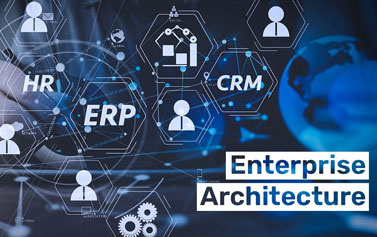
Future Trends in Enterprise Architecture
Enterprise architecture (EA) is a holistic approach to managing IT assets, processes and people required to meet an organization’s needs as it responds to real-world conditions. The goal of EA is to create an effective representation of the business enterprise that may be used at all levels of stewardship to guide, optimize, and transform as it responds to disruptive forces.
Growing Relevance of EA
EA was initially conceived as a process to manage and distribute technology assets. As the importance of technology in business increased, the objectives and functions of EA evolved. By 2023, according to a Gartner study, 60% of organizations will rely on EA to lead the business strategy to digital innovation.1
What Does the Future of EA Look Like?
Enterprise architecture in the future will be about designing for digital transformation and fulfilling the need for innovation and flexibility. It will involve predictive analytics, data science, artificial intelligence (AI) and machine learning (ML) to understand how an organization is currently functioning and how it can be improved. Future trends in EA will be focused on prioritizing business capabilities and orchestrating technology, processes, and people to optimize business goals.
Future Trends in EA
Let’s take a look at four of the top future EA trends.
- Intelligent Multi-Experiences Powered by AI And ML
In the future, EA will be developed around intelligent multi-experience applications and solutions. For example, new customer and employee experiences will be created with new technologies such as Augmented Reality (AR), Virtual Reality (VR), Extended Reality, and Mixed Reality at their core. These new intelligent experiences will be largely driven by AI and ML technologies. It will be necessary for enterprise architects to comprehend domains such as Responsible AI, AIOps, and Responsible and Composable Enterprise.
- Hybrid Cloud and Microservices
Hybrid cloud enables a company to keep leveraging their on-site infrastructure with a combination of private and public cloud services. It allows them to scale on-demand and take advantage of AI/ML capabilities. Microservice architecture has made it easier for teams to code better, debug, and deploy faster. Enterprise architects need to equip their development teams with the most optimized tools for better management of containerized applications in a hybrid cloud environment.
- Edge Computing
In EA, edge computing is redefining the way industries optimize data capture, and scale and automate their systems and business processes. In manufacturing, edge technology is disrupting the way manufacturers process and analyze their production and equipment data. Edge computing is significantly impacting the healthcare industry by cutting costs and improving productivity through the use of technologically-enabled equipment, tracking and monitoring diseases, and providing health advice based on data.
- DevSecOps and Agile Frameworks
DevSecOps assists security practitioners in adapting and changing older, existing security processes and procedures. Agile enables business and development teams to collaborate and work together to improve delivery processes. Enterprise architects can help guide their organization towards successful outcomes by designing and implementing these programs according to company requirements.
With the accelerated rate of digital transformation in the modern enterprise, most companies are adopting new agile methodologies, IoT, AI/ML or migrations to the cloud and microservices. To align and navigate this fluctuating environment, enterprise architects will need to rise to the occasion and design operating models that effectively incorporate people, processes and technology, while remaining flexible, scalable and adaptable to the changing demands of stakeholders.
1 Gartner Study: “Enterprise Architecture Enables Digital Innovation”, Feb 22, 2021: https://www.gartner.com/smarterwithgartner/enterprise-architecture-enables-digital-innovation
